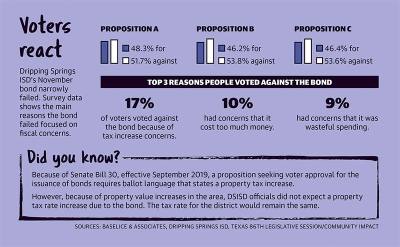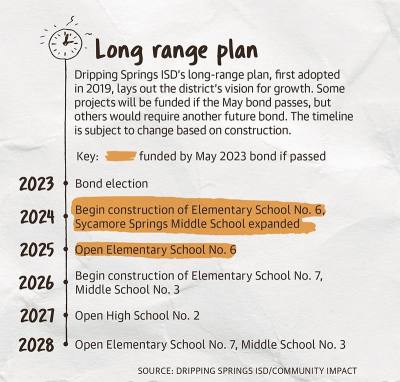The 2023 bond, aimed at addressing both capacity issues and maintenance needs at its schools, is $257.43 million less than the November attempt. The biggest change is leaving out construction of a second high school.
In the last 10 years, DSISD enrollment has increased by 82%, causing three of eight campuses to become overcapacity with three more predicted to reach capacity by 2025, according to DSISD.
If the additional bond fails, the district will address growth by rezoning and shifting the student population within facilities and purchasing portable classrooms.
“We’re going to have a sea of portables and will need to increase class sizes to have as many kids in the building,” Superintendent Holly Morris-Kuentz said during a bond workshop Feb. 10.
Growing district needs
In May, the district will ask for $223.70 million for new facilities and capital improvements.
For the 2024-25 school year, two additional portable classrooms will need to be purchased to accommodate student growth. If the bond fails, 14 portables will need to be installed. The district has already purchased two portables for the 2023-24 school year for Walnut Springs Elementary School.
Similar to the November package, the district is seeking to construct a new elementary school, expand Sycamore Springs Middle School, and design a new elementary school and middle school.
The difference in this bond package is the district will not ask for construction of a new high school. By splitting the design and construction of the new high school over two bond elections, the district can reduce the amount of money it asks for in a bond and fund a visual that can be shared with the community, DSISD Deputy Superintendent Elaine Cogburn said.
“We still have the same facility needs; the maintenance projects haven’t changed,” Cogburn said. “None of the needs have really changed. It’s just what kind of package will the community support?”
To prepare for the bond presented to voters in November, two DSISD organizations made up of community members and residents, the Long Range Facility Planning Committee and the Bond Steering Committee, helped the district prioritize projects.
The November bond package had three propositions focused on the design and construction of new schools as well as maintenance repairs to facilities.
“We know we have student growth coming and that our current facilities won’t accommodate all of that growth,” Cogburn said. “And the only way for a school district to build a campus is to ask the voters for the authority to issue bonds.”
About 52% of DSISD voters turned down each proposition.
“It’s not about whether or not we need or want new schools; it’s a matter of how much we’re spending for them,” Dripping Springs resident Michelle Mostert said. “The voters spoke: They don’t want to pay the high price the board has come up with.”
Understanding the costs
The biggest factor contributing to voters deciding against the propositions was a concern for a tax increase, according to a survey of DSISD voters conducted by research firm Baselice & Associates.
“If the taxes keep going up, people who work in the schools are not going to be able to afford to live here,” Mostert said.
DSISD officials said the tax rate would not have increased because it already generates enough revenue to pay outstanding bonds and the bonds issued if the propositions had passed.
DSISD’s total tax rate is $1.3103 per $100 property valuation for the 2022-23 school year. While this rate, set by the district, did not increase from the year prior, property values have increased.
The median taxable value on property for DSISD homeowners increased by 50.62% from 2021 to 2022, meaning tax bills grew, even when the tax rate did not.
Texas law requires language on a ballot to include the statement: “This is a property tax increase,” regardless of the impact on the district’s tax rate. The law comes from Senate Bill 30, which became effective in September 2019.
Before the election, the district is working to educate voters on the finances of the district and the language regarding taxes through monthly informative sessions.
“Confusing information on the ballot, coupled with confusing information by social media and a distrust of what the district is saying, made it not feel safe to vote ‘yes‘ for the bonds,” Cogburn said. “And that’s what we’re trying to change is feeling safe that what the district is telling you is correct and feeling safe that you can continue to afford to live in your house.”
Planning for overcapacity
Five portables have been installed for the 2022-23 school year at Dripping Springs Elementary and Sycamore Springs Middle schools.
Terry Purdy, parent to two students and chair of Friends of Dripping Springs Education, reported that on her daughter’s first day of school at Sycamore Springs Middle School, students had to sit on the floor because there wasn’t enough room in the classroom to sit.
A portable classroom costs the district $234,000 on average with additional costs incurred to move the portable and set up power, air conditioning and ramps for access.
“Continuing to cram a child into a classroom which is bursting at the seams, packing kids into overcrowded cafeterias, and forcing students and teachers into portables out by the parking lot is just plain wrong,” DSISD parent Aaron Buzali said.
The bond package for May was finalized Feb. 17. Election day is May 6.
“Regardless of the outcome of the bonds and the board meetings, our staff is left with whatever constraints are given to them,” Purdy said. “It’s important to our community to show appreciation to our staff and to remember we are voting on impacts of all that.”








